Management Strategy Implemented In MNCs Organization Sample Assignment
A critical evaluation of reward management strategy implemented in MNCs organization for achieving a bench marking process:
A case study of TESCO Plc
Abstract
The primary aim of the dissertation is to analyse the reward management strategy of an organisation. The researcher in this project will project the details with relevant information and concept that will enable the readers to understand the process of the reward management and the steps that are involved in the process to provide a fully functional productive workplace. Therefore, the researcher believes that this project will help to unravel the information accordingly and place all the vital information for a better and a clear understanding. The researcher will be doing a proper research on the project and make sure that the information, which will be gathered, will be used for proper analysis so that a proper outcome can be achieved. The researcher will be discussing the matter with the help of the proper strategies and models that will help in proper filtration of the information. The researcher will be using varieties of technique to make sure that the research outcome will provide appropriate understanding. The researcher will be highlighting the data with the help of the tables and diagrams to provide a transparent understanding that will enable the reader to understand the matter productively. The researcher believes that with the information collected and analysed it will help the future researchers for the study
Chapter 1 - Introduction
1.0 Introduction
In this first chapter of dissertation, the researcher will give the aim, objectives and questions of the concerned research topic. Here the researcher will also provide the background of the topic, background of the company, rationale of the study and a structure of the dissertation. Reward management strategies have the power to deal with employee productivity and performance control. Thus, this can help the company to increase their business locally, nationally and globally. Therefore, different industries should be focused on collecting and analysing information from other organisations related to employee motivation, preferences and expectations as it plays a vital role while generating the ideas of the strategy that is to be implemented. However creating a competitive yet innovative strategy requires a vast knowledge and skill of understanding the business activities and the factors that can flourish a business. Otherwise, if the innovative strategy cannot be effective then it can have a wide negative impact on the business of the company. Therefore the managers should be very careful and concentrated while making such strategies. Here the researcher has chosen Tesco PLC in UK to carry out the research in order to analyse the effectiveness of reward management and how new strategies can help the organisation to sustain in the market without degrading their performance and productivity in the market.
1.1 Background of the topic
Formulating and implementing effective reward management strategy is considered as the most important aspect of recent business world. Market competition has become so high that the companies need to be focused on their strategic implementation. In order to make an effective strategy it is very important for the management team of a company to analyse the internal and external business environment and formulate their strategy accordingly so that it can be fruitful for the company. Controlling employees includes several interconnected commissions and activities. In order to develop an employee-familiarized company the mangers should have the skills that are required to bring the necessary changes in the business productivity. It is essential for the organisation to understand the role and contribution that employees bring to the organisation.
1.2 Background of the Company
Founded in the year 1919, Tesco was founded by Jack Cohen. The organisation comes from England and serves in 8 different countries. Over the years, the organisation has opened its various subsidiaries to retain consumers and take care of its employee as well. The organisation earned £56 Million in 2017 and has an employee base of over 480,000 as of 2017. The organisation lies in the retail industries and their main business is grocery and general merchandising. Based on the reports published by BBC, (2017), Tesco is considered to be the third largest retailer when it comes to profit and holds 9th position when it comes to revenue. Over the years, the organisation has expanded to various countries and expanded their business globally to gain market dominance.
1.3 Rationale of the Assignment
As the market is growing over the time, the competition has increased immensely thereby affecting the business process of many organisation. In this dissertation, the researcher analyses the impact of globalisation and the organisational performance of Tesco in recent times. The researcher also plans to analyse the employee performance and the motivational strategies that the organisation applies in the organisation for their employees to retain them and recognise their talent and contribution towards the organisation’s goals and objectives. Throughout the years, the organisation has retained its employee by implementing various incentive bonus and others, however, with new companies coming in the market, they are not able to retain them since other organisations are offering much more benefits. Some employees are able to resist the offer due to their loyalty, while some are grabbing the opportunity for a better standard of living. The study focuses on the changes that occurs within an organisation when new company comes in the market. The study deals with the reward management strategies put forward by the organisation to retain them.
1.4 Research aim
The aim of the research is to identify and analyse the effectiveness of the reward management strategy those are implemented on the multinational companies in order to achieve the bench marking process. For conducting the research, the researcher has chosen the Tesco Plc.
1.5 Research objective
As per the topic the key objectives of this research are:
- To understand the reward management strategy
- To analyse the importance of the bench marking process of the MNCs organisation
- To evaluate the impact of the reward management strategy to achieve the benchmarking process for Tesco Plc
- To find the related issues of implementing the reward management strategy and to suggest some recommendations accordingly
1.6 Research question
The questions of this research are:
- What is reward management strategy?
- What is the importance of the benchmarking process for a MNCs organisation?
- How much the reward management strategy is effective in order to achieve the bench marking process for Tesco Plc?
- What are the loopholes of implementing the reward management strategy for the Tesco plc?
1.7 Structure of the dissertation
Here is a structure of the dissertation has been provided by the researcher to make it easier for the reader to understand the topic adequately. In the first introductory chapter, the researcher has provided the basic knowledge of the topic and the aim and objectives of the research. The background of the research and the company and the rationale of the study have also been stated here. Second chapter of the dissertation includes the related models and theories of the research topic to acquire better knowledge about the topic. In the third chapter, the researcher will choose the proper design, methodologies, and techniques to carry out the research work efficiently. In the fourth chapter, the researcher will analyse the collected data from the primary and secondary survey. In the fifth chapter the researcher will provide a conclusion of the whole research and provide some apt recommendations if required.
1.8 Summary
In this chapter, the researcher has provided the description of the topic, background of the company, rationale of the study, aims, objectives, and questions accordingly. In the next chapter, the researcher will provide relevant models and theories regarding the topic to attain a deeper and clearer knowledge about the research topic in order to gain a better outcome.
Chapter 2 – Literature Review
2.0 Introduction
In order to discuss the information critically, the researcher applies secondary reliable sources that provide different angles to the discussions and bring relevant solutions based on the same. The researcher discusses the information with the help of various theories and models to provide a better understanding of the information. This section covers different information on reward management and new strategies that are being adapted by the organisation over the times to retain their talented employees. With the help of these information, the researcher will be able to draw good conclusions that can help them to sustain in the business.
2.1 Reward Management and Policies
Reward Management is concerned with the formulation and implementation of strategies and policies that aim to reward people fairly, equitably and consistently in accordance with their value to the organization (Armstrong, 2008). It deals with the design, implementation and maintenance of reward practices that are geared to the improvement of organizational, team and individual performance. Reward management forms the employment relationship. Thus if an HR Manager is to succeed in successfully managing the employment relationship he/she will have to do well in Reward Management otherwise there will be an imbalance in the employment relationship such as strikes and lockouts e.g. Telone (Adair,2010).
Characteristics of a good Reward Management system
- Simplicity- a good Reward Management system must be easily understood by everyone in the organization. Thus people must understand why they are getting what they are getting from the employment relationship.
- Fairness and equitability- every component of the system must be justifiable and consistently applied. This element is arguably the most challenging to implement and is the cause of most Reward Management related problems such as strike, turnover, dissatisfaction etc.
- Perceived fairness and equitability – Sometimes having a fair and equitable reward management system is not enough. It must be understood as being fair and equitable. This could be achieved through effective communication and training. A survey of most reward management problems indicated that there are a result of perceived inequity and unfairness rather than actual inequity and fairness.
- Participatory – A reward management system that is simply dictated to by management is not bound to work. An effective one should ideally be negotiated and agreed between management and employees.
2.1.1 Total Reward Model
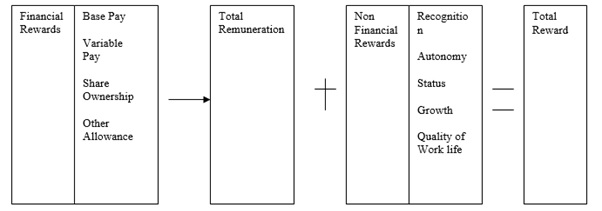
Fig1. Total Reward Model
(Source : Edd, 2011)
The concept of total reward recognizes that in an employment relationship there is more that employees want and value than just money. Thus a prudent reward strategy bent on attracting, retaining, motivating and satisfying employees and making a strategic contribution should adopt the total reward model which highlights the question “Is money the most important element of reward?” (Edd, 2011).
2.2 Reward Management Strategy
A reward strategy just like any other strategy in the organization must seek to address an organization’s bottom line. Its purpose must therefore be to support the corporate strategy and address organizational needs.
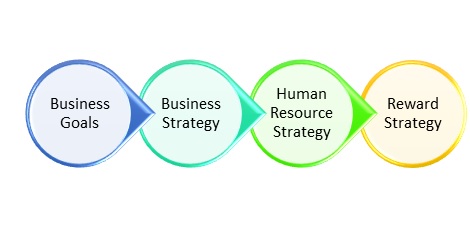
Fig2. Reward Management Strategy
(Source: Smither, 2006)
2.2.1 Generic Reward Management Strategies
Base Pay Reward strategy
Traditionally companies have always adopted the base pay strategy that as the reward management strategy. This strategy a company pays the legal minimum wages and salaries. However it became apparent that this strategy was not adequate in new work cultures and in terms of attracting, retaining and motivating top performers for strategic purposes (Bremen et al. 2012).
The following then became the new options:
Knowledge and skills based strategy
Because of the proven co-relation between skill/knowledge and on the job performance, organizations have sought to encourage continuous skills development by tying it to rewards. In this strategy an organization simply varies its pay structure according to one’s level of knowledge and skill (job evaluation systems). For this strategy to bear fruit an organization must first define which skills it values and will pay for and must have a supportive training and development strategy. In practice this strategy will be based on base pay with an equal base pay and a variation based on skills and knowledge. While this strategy may be costly in the short-term, in the organization run it is beneficial, as the organization will begin to benefit from a knowledge HR base through increased productivity and quality of products (De Wit and Meyer, 2010). Thus this strategy is a good example of how a reward strategy can address an organisation’s bottom line.
Performance Based (Variable pay) based structure
This strategy is arguable the most strategic from organizational point of view as it strikes a balance between what the employee gives into an employment relationship and what he gets out of it. It recognizes and is based on the philosophy of reward management – that employees should be rewarded only for the value they create. This strategy seeks to scientifically align one’s reward to the value he/she would have created. In this strategy a company will reward employees in the same grade variably depending on each employee’s performance (Bellamy, 2012). Obviously for this strategy to work the organization must have a sound performance management system.
Incentive Based Pay Structure
The incentive based pay strategy is similar in terms of philosophy to the performance based strategy in that it also links reward to certain performance measures but being different in that it focuses on group performance rather than individual performance. The starting point in this strategy is to define group performance targets such as productivity sales volumes or profitability. An achievement in each of these categories will be accompanied by commensurate rewards such as productivity bonus or profit sharing for management. At individual level the most common form of this strategy is piece-rate pay where an employee is paid purely for what he/she produces without a base pay e.g. sales reps, like the performance based reward strategy this strategy addresses on organisation’s bottom line as it is based on organizational performance and is commonly used for managerial employees (Bergh and Ketchen, 2013).
2.3 Reward Management Policies
Consistency and Fairness are critical elements of reward management with a capacity to make or break a reward management system, a clear reward policy outlining the following is a must.
- The job evaluation and differential method
- An organizational pay stance
2.3.1 Generic Pay Stances/Reward policy
Market Stance/Market Rate policy
Here the organization simply pays according to prevailing Market rates. Such an organization will be found engaging in salary surveys to determine market freely.
Below Market policy
Here an organization will be paying below prevailing market trends. However this policy will have to be supported by other non-pay rewards if it is to make any business sense.
Above Market policy
Here the organization first surveys the market and sets its pay structures slightly above the going market rate. This policy pays dividends in terms of attracting and retaining good talent.
Differential Pay policy
Here an organizational pay policy is to vary levels of pay depending on individual or team performance.
The Flexibility policy
Here the organization’s reward policy is not to adopt any particular strategy or stance but to remain flexible and adapt to any current company and employee needs.
2.3.2 Factors that affect an organization’s Reward policy and Strategy
- Affordability – what an organization can afford to pay. The argument here is that an organization cannot borrow to reward employees but should reward from the value created by the employees themselves. However in any case an organization has to afford to pay above legal minimums.
- Legislation- legislation sets the minimum base pay (minimum fixed pay rate), which becomes the starting point in calculating for all of an organisation’s policies.
- Trade Unions/workers committees – depending on the power of a union, pay levels are determined through collective bargaining. The most powerful ones will strike higher levels.
- External job value – the market value of the job e.g. what is the market value of an Hr Manager or CA?
- Internal job value – the value or perceived value of a job compared to the other jobs which the organization will determine the reward for that job e.g. Hr manager compared to Finance manager.
- Value of the person – employees holding similar jobs can be paid differently depending on the value to the organization performance.
- The economy – (labour supply/demand). A depressed economy increases the supply of labour, which in turn reduces its price and hence affects reward policy strategy.
2.4 Impact of Reward Management Strategies on Employees
As stated by Bryman and Bell, (2011), reward management processes are conceived with the design, implementation and maintenance of reward systems geared to the improvement of organizational, team and individual performance. As opined by Hope et al. (2005), to be motivators, rewards must be aligned with the things they that people value. The reward can be determined by simply asking employees what things want. Employees will vary in their response, because some employee value monetary reward, where other value scheduling flexibility, especially training and development opportunities. Some people sees that the jobs as a sources of a pay cheque and nothing else. Others derive great pleasure from their jobs and association with co-workers. The subject of organizational rewards includes, but goes far beyond, monetary compensation. Reward management is also concerned with those nonfinancial rewards that provide intrinsic and extrinsic motivation. Intrinsic motivation is achieved by satisfying individual needs for achievement, responsibility, variety, change, influence in decision-making and membership of a supportive team. Extrinsic non- financial motivation provided directly by the organization is achieved by recognition, skills, development and learning a career opportunities. According to Lawler, (2008), individual differences in what employees desire and find motivating, forces managers to recognize these individual difference and managers should think about reward more broadly.
Intrinsic rewards
As put forward by Lawler, (2003), intrinsic rewards as personally satisfying outcomes, and they include feedings of achievement and personal growth. Psychic rewards. Intrinsic rewards because they are self-granted.
Extrinsic Rewards
Camardella, (2007), say an extrinsic reward are outcomes supplied by the organization, and includes salary, status, and job security and spring benefits. One can compare these rewards to the job context items that Camardella called integrative factors According Chan and Lynn, (2008), an alternative typology for organisational reward as is the distribution between extrinsic and intrinsic rewards financial, materials and social rewards quality as extrinsic reward because they from the environment.an just pay- linked options.
2.5 Herzberg’s two-factor theory of motivation
Frederick Herzberg had close connections with Maslow and believed that there was a two factor theory of motivation. Herzberg suggests that there are certain factors that an organisation could introduce in order to directly motivate employees to work harder, these are known as motivators. However, there is also the ability to de motivate an employee which is known as hygiene factors. Herzberg found that certain characteristics tend to be consistently related to job satisfaction, intrinsic factors, such as achievement and growth. When respondents felt good about their work they related that to themselves. However, when they were dissatisfied with their work they tended to cite extrinsic factors such as company policy (Moore, 2007). He found that removing dissatisfying characteristics from a job does not necessarily make the job satisfying. He thus proposed a dual continuum, where the opposite of satisfaction would be no satisfaction and the opposite of dissatisfaction would be no dissatisfaction.
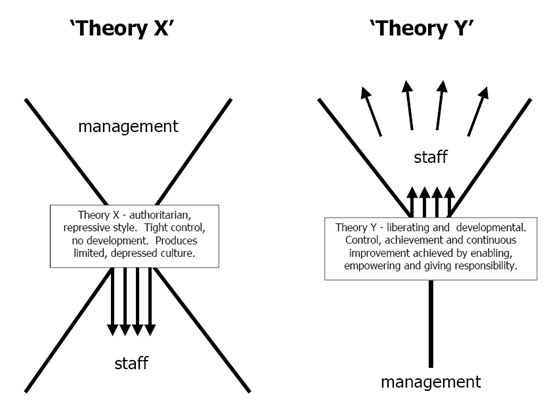
Fig3 Herzberg Motivation Theory
(Source: Camardella, 2007)
According to the two factor theory of motivation, organisation cannot begin to motivate their employees until the dissatisfaction has been removed. Hygiene factors such as salary, working conditions and supervision are not motivators even when they are being met. True motivation only kicks in when an employee’s higher-level needs are met. The relevance of Herzberg’s theory to the discussion of reward and recognition is that a dissatisfied employee cannot be motivated. It is thus important that an organisation first give attention to hygiene factors before introducing motivators into the workplace.
Intrinsic to Herzberg’s theory is the fact that only motivators cause true motivation since the hygiene factors are of short-term duration, they could never be truly associated with work motivation. Rather they would be involved in reducing negative factors in the work environment. The criticisms of this theory relate to the issue that the two factor results is observes as a result of the issue that it is natural for people to take credit on levels of satisfaction and to blame dissatisfaction on external factors. The main area that people criticise here is that they do not believe that job satisfaction necessarily implies that there is a sufficient level of motivation or productivity. Herzberg states that the reasoning here is that the factors causing satisfaction are different from the reasoning behind dissatisfaction and that as a result of this they cannot just simply be treated as opposites of one another.
2.6 Total reward management
If organisations are more upfront about what they are demanding, then they should also be explicit about how they can reward individuals who go the extra mile. “Organisations must reward employees because, in return, they are looking for certain kinds of behaviour: they need competent individuals who agree to work with a high level of performance and loyalty. Individual employees, in exchange for their commitment, expect certain extrinsic rewards in the form of promotions, salary, fringe benefits, bonuses, or stock options. Individuals also seek intrinsic rewards such as feelings of competence, achievement responsibility, significance, influence, personal growth, and meaningful contribution. Employees will judge the adequacy of their exchange with the organisation by assessing both sets of rewards. The process of developing and implementing strategies, policies and systems which help the organisation to achieve its objectives by obtaining and keeping the people it needs, and by increasing their motivation and commitment.” It also relates to intrinsic as well as extrinsic motivation, the non-financial as well as the financial rewards.
2.6 Total Reward Management Programme
As opined by Chan and Lynn, (2008), Towers 2005 developed a model of total rewards which is seen to be one of the more important theories of reward management.
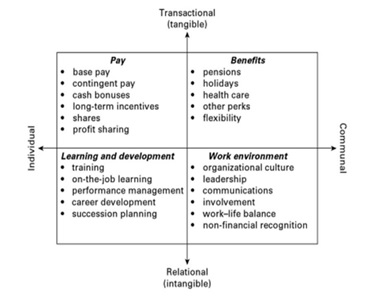
Fig4. Total Reward Model
(Source: Lawler, 2003)
The upper two quadrants which are pay and benefit relate to the transaction rewards which would be financial in nature and are what organisation would use in terms of recruiting and retaining their employees. The contrasting quadrants would relate to relational rewards which would be non-financial in nature. These quadrants are used in order to enhance the value of the upper two quadrants. (), suggests that the real power comes when organisation combine relational and transactional rewards.
What this model consists of is five elements of reward which include compensation, benefits, work life balance, performance and recognition, and development and career opportunities. The compensation aspect is related to the pay provided by the organisation to an employee for services rendered which would include both fixed and variable pay. Benefits would relate to the programs and organisation uses in order to supplement the compensation in which that the employee shall receive. What these benefits do is provide security for the employee and their family. Work life balance is a specific set of practices, and programs in order to actively support efforts that will ensure the employees achieve success in both the work and at home. The performance aspect of performance and recognition relates to the effort towards achieving goals within the organisation. What is involved in this area is the expectation and continuous feedback. The recognition aspect is the part in which acknowledges the employees efforts. What it relates to is the meeting of the intrinsic psychological needs of the employee for appreciation in the workplace. The development aspect of development and career opportunities relates to the learning experiences in order to enhance an employee’s skills. Development of an employee can benefit both the employee and the employee’s organisation. Career opportunities involve the recognition by the employee to further their career and establish new career objectives. Development and career opportunities not only help the employee but they also add value to the organisation. The method of cash payments as incentives can be seen to be expensive on an organisation, incentive alternatives can be seen to be just as successful as they can be seen to tailor to the individual and help them in achieving their organisation objectives What this means is that an organisation must have the ability to choose relevant rewards that will be able to link to their job.
2.6.1 Benefits of Total Reward Management
Moore, (2007), provides a powerful argument for a total rewards approach stating that “Creating a fun, challenging, and empowered work environment in which individuals are able to use their abilities to do meaningful jobs for which they are shown appreciation is likely to be a more certain way to enhance motivation and performance - even though creating such an environment may be more difficult and take more time than simply turning the reward letter”
There are three trends favouring the increasing use of recognition. These trends are as follows:
- The trend toward increased uncertainty, relates to the organisation and the rapid changes involved in this changing environment where there is a growing need to be more flexible and also to increase the use of informal controls such as recognition and feedback.
- The trend towards fixed compensation, which relates to compensation programmes that freeze salaries and also merit increases paid on a bonus basis. Informal rewards would be a way in which would help in accommodating the need for reinforces as what can become of this is pressure of the organisation.
- The trend toward empowered employees, relates to having increased responsibility in the interest of the organisation. What this means is that the organisation must provide employees with more flexibility in order to be more innovative. Informal rewards can help reach desired outcomes.
Hope et al. (2005), discusses in his article the concept that organisations need to focus on evolving their rewards program in order to have a balance within the organisation. What this means is that the organisation designs a suitable rewards program in which will be balanced in terms of the needs of the organisation. What this balance will entail is in terms of the business cycle and also the direction in which the employees will be headed. Organisations have previously been encouraged to test out different combinations of total rewards and look at the results given to the organisation using sophisticated quantitative models. The reasons that the organisation have been encouraged to do this is that for the organisation they can look at how various combination influence the behaviours of their employees. The main focus here within this article is looking at understanding the relationship between the total rewards program and employee value prospector. Within this article we can see that an organisations employee value prospector is far greater than jobs, colleagues and mission statements. Organisations familiarise the term total rewards with the combination of monetary and no monetary structures, Bremen, J.M states that “whether a company manages its rewards programs holistically or in discrete functional silos, a total rewards philosophy underscores the value gained”. The overall objective here as stated by Bremen, J is that the employees will be influenced in a positive way which will have a knock on effect on customer satisfaction resulting in revenue growth for the organisation.
2.7 Gap of Literature
During the research, the researcher has faced difficulties in gaining the information of the theory and the models accordingly. The researcher had to make proper structure for the information gathering, which was a difficult task, and it involved a lot of research, which consumed time. The researcher also faced difficulty in collecting the information from the internet. The information was incomplete and had inappropriate data that was manipulated. Therefore collecting the information was difficult. Due to time limitation, the researcher was unable to perform an in-depth research. The researcher had to rely on the journals and reports, which were at least 5 years old.
2.8 Summary
The researcher has discussed about the reward management and strategies accordingly with the help of the relevant models and strategy, which has proven to be beneficial for the completion of the discussion. The researcher has explored various segments concerning towards employee retention, motivations, reward and recognition.
Chapter 3
Research Design and Methodology
3.1 Introduction
Research design and methodology is considered an integral part for the project development as it involves the stages of the research that will be useful in collecting the data accordingly (Bergh and Ketchen, 2009, p-131). In this chapter, the researcher will be discussing the various research methods and style for the data collection that will help for the data gathering. The researcher will be explaining the various philosophies, approach and design to state the purpose of the research and provide information on the data collection method. The researcher believes that with the help of the research, collection of the data will be more organised and appropriate for the benefit of the study for proper understanding the topic.
3.2 Method outline
The researcher believes that with the help of proper direction, fetching the information will be appropriate for the study and help the researcher in collecting the information effectively. The method outline of the research is,
- Research Onion
- Research Philosophy
- Research Approach
- Research Design
- Data Collection
- Sampling
The researcher believes that with the help of this format and proper elaboration and understanding, the researcher will be able to fetch the required information accordingly for the benefit of the study accordingly. The researcher believes that with the help of these stages the research can find appropriate data for analysis.
3.3 Research onion
Research Onion is an effective stage for shaping up the research as it helps in doing the research effectively. The layers of the research onion helps the researcher in making proper approach and provide proper understanding to the research and the data. The research onion has several layers, which helps the research for the appropriate development (Bernard, 2011, p-247).
The stages in the research onion are,
- Philosophy
- Approach
- Strategy
- Choice
- Time horizon
- Techniques and procedures
With the help of the research and its stages, the researcher believes it will provide adequate amount of data and help the researcher in selecting the appropriate research data collection.
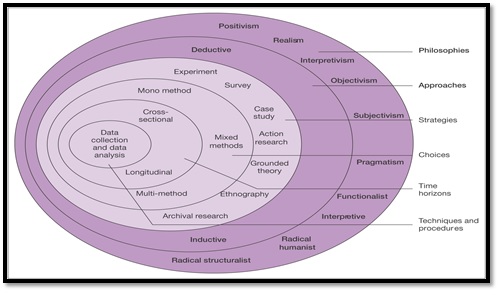
Figure 5: Research Onion
(Source: Saunders et al. 2009, p-52)
With the help of the research onion, the researcher will be able to provide appropriate information on the research study accordingly.
3.4 Research philosophy
Research philosophy is vital for the selection of the research process as it helps in understanding the nature of the research accordingly (Cameron, 2009, p-142). For most of the research study, the researcher believes that the philosophy guides the research accordingly. The philosophies are,
- Positivism
- Interpretivism
- Realism
The researcher believes that these stages are most effective for the research.
Positivism is gathered from the experiences and facts, which deals with the facts and data, which are believed to be positive in nature. These are done through logical, rational and mathematical treatment, which helps the researcher in gaining appropriate information (Ellis and Levy, 2009, p-333). Interpretivism and realism helps the researcher in making the appropriate connection to the philosophy and believes that it helps in identifying the cause of the research more transparently.
3.4.1 Justification for the selected philosophy
The researcher believes the use positivism philosophy for the will be beneficial for the research and help for the proper development of the study. Positivism will help the researcher in providing the practical knowledge of the data and help the reader to provide the logical treatment accordingly for the better understanding of the research.
3.5 Research approach
Research approach is the stage, which helps the researcher in shaping the research study further by understanding the different approach for the study. The researcher believes that the approach will help in shaping up the section accordingly for data collection study. The research approach is divided on to 2 categories, which are,
- Deductive
- Inductive
With the help of the research onion the study of the research has become organised and therefore the understanding of the segments have become clearer.
Deductive Approach is the approach, which helps the researcher in making logical reasoning with valuable points and facts, which are not vulnerable due to the presence of the real time data and information. It has several layers, which can help the researcher in making the research more productive and effective (Freshwater, 2007, p-136).
Inductive Approach can be explained where the approach states that it is opposite of the deductive approach and uses a proper explanation for the study, it is divided in to the stages of the proposition and presumption that helps the researcher in making the steps wisely for usage.
3.5.1 Justification for the selected approach
The researcher believes that with the help of the deductive approach, the researcher will be able to provide the information more effectively as it uses several layers, which are considered real in nature, and has appropriate information for the analysis (Harrison and Reilly, 2011, p-13). The Deductive approach will help the researcher in making proper presentation of the study.
3.6 Research design
The researcher believes that with the use of the proper research design, the researcher will be able to point out the effective research data collection for the collection of the data and believes that with the help of the information gathered from the research, the researcher will be able to portray the data respectively.
The research design is divided in to 3 parts, which are,
- Exploratory
- Explanatory
- Descriptive
Exploratory is the stage where the researcher believes that the information be fetched with the help of the sources and the proper network, which will enable the grasp of the study to be strong. Explanatory is the stage, which will deal in the stages of the explanations that be proven beneficial for the study accordingly. Descriptive research design will help the researcher in making data more effectively as it will involve a real time data collection for the research and thus the information will be completely fresh for the analysis (Huxham and Vangen, 2008, p-389).
3.6.1 Justification for the selected design
The researcher believes that the use of the descriptive approach of the study will help the researcher in making proper presentation of the study, which will be effective for the collection of the data and help the researcher in making proper presentation.
3.7 Research purpose
The purpose of the research is to collect data, which will help in providing the needed information for the study. The purpose of the research is to identify the market position of the company, which is Royal Dutch Shell and understand the consumer acquisition of the company.
3.7.1 Data sources: primary and secondary
The data will be collected for the research based on two criteria, which are primary and secondary. The primary data will consist of the information, which are completely fresh and raw in nature and will be perfect for the analysis. The secondary sources of information will be based on the data gathered with the help of the internet and the journals, which will be at least 5 years old (Johnson et al. 2007, p-118) The researcher believes that with the help of these sources the research will get the appropriate and needed shape for the development of the data collections.
3.7.2 Data collection method: qualitative and quantitative
The use of the primary and the secondary sources of information will be useful for the data collection as it involves the stages of qualitative and quantitative (Knox, 2008, p-121). With the help of the primary data, the researcher will able to fetch the information directly from the real time world, which will help for the proper development of the study and enable the researcher in presenting the information productively. The researcher believes that the use of the participants in quantitative and qualitative will be appropriate for the data collection and will enable the researcher to collect information for the study respectively.
3.7.3 Data analysis
Data analysis is the stage where the researcher describes the use of the tools which will be used for the analysis of the data (Magilvy and Thomas, 2009, p-299). The researcher believes that the use of the internet and computer are essential for the analysis. With the help of the data analysis, the information will be verified effectively and make proper understanding on the study. Data analysis is an integral part for the outcome of the study and helps to identify the loopholes (Morgan, 2007, p-51). The researcher believes that the use of analysis will be an important section in the research study respectively.
3.8 Data collection procedure
The researcher will be collecting the information with the help of the survey, which will help the researcher in identifying the topic respectively. The researcher will be taking the assistance of the respondents and the managers for the development of the business accordingly. The researcher will be using the primary data stage and its subsection, which are the qualitative and quantitative stages. With the help of these two stages, the data will be more effective and very easy to understand and analyse. The collection procedure has to be effective as the data is completely dependent on the appropriate collection procedure (Onwuegbuzie and Leech, 2009, p-381).
3.8.1 Population and sampling
The researcher believes that population and sampling are considered to be the most important for the development of the research accordingly as it helps the researcher in gathering the information with the help of these participants. The participants of the quantitative analysis are the population of the research along with the managers of the company. Samplings are based on two stages, which are the probability and non-probability techniques, which are said to be useful for the research accordingly as it helps in proper development of the study and enables the researcher in making proper progress with the help of the population.
3.8.2 Sampling technique
The researcher will be using the probability and non-probability sampling for the research to make the study effective. It is more concrete and supportive for the data collection. For the quantitative data, the researcher believes in collecting the information with the probability sampling technique and qualitative information with the non-probability sampling.
3.8.3 Sample size
The researcher believes that the assistance of 3 managers and 50 respondents for the study is enough for the collection of the data in the provided time window. The researcher expects the information to be appropriate with the help of these participants and collect productive information for the study.
3.9 Ethical considerations
The researcher understands and believes the risk factors that are involves in the stages of data collection and therefore makes sure in making the risk minimal by,
Approval: the researcher will take approval of the company to interview the managers of the company over Skype. This will help the researcher and the managers to save time.
Respondent Identity: the researcher will make sure of not using any names in the research and will not use the list for commercial purpose. The identity of the participant will be anonymous.
Participation: the researcher will make the interaction of the respondents voluntary and will not force or pressurise for completing the research. They are free to quit the process whenever they feel like.
3.10 Research limitation
There are certain limitations, which are faced by the researcher during the completion of the research. The researcher believes that the use of the secondary sources, which is journals and reports, are considered to be in appropriate for the study and are manipulated for the commercial use. The researcher also believes that there might be a biased statement from the managers of the company as they are the employees of the company and they are not going to state information against the company.
3.11 Time horizon
|
Key Research Actions |
1st week |
2nd week |
3rd week |
4th week |
5th week |
6th week |
7th week |
8th week |
9th week |
|
Selection of the topic of the research |
ü | ||||||||
|
Collection o the secondary data |
ü |
ü |
ü | ||||||
|
Writing the literature review |
ü |
ü | |||||||
|
Selection of appropriate research tools |
ü | ||||||||
|
Data analysis |
ü | ||||||||
|
Writing of Conclusion and Recommendations |
ü | ||||||||
|
Editing the reference list |
ü | ||||||||
|
Draft creation |
ü | ||||||||
|
Final dissertation |
ü | ||||||||
|
Cross checking and submission of the final work |
ü |
3.12 Summary
The researcher has stated the information against the study based on the information, which is related to the topic. The researcher has explained the research philosophies critically and has stated the research approach and design of the study. The researcher believes that the use of the primary and secondary data will be useful for the information analysis. The researcher has also used the research onion to state the information of the study affectively, which will help the reader in making necessary presentation of the study with participation of the respondent and Managers.
Chapter 4 - Data Analysis and Interpretation
4.0 Introduction
In this chapter, the researcher will collect all the relevant data of the research topic through primary and secondary survey and then the data will be analysed by the researcher to attain a better result and to identify the issues of the research. Therefore, this is considered as the most important chapter of dissertation. Here the researcher will gather the opinion of the employees and managers of Tesco PLC to carry out the primary survey in order to analyse the impact of reward management strategies on sustaining and retaining market competition and employees. After analysing the gathered feedback of the employees and the mangers, the researcher will be able to provide a clearer outcome of the research.
4.1 Quantitative Analysis
Q.1 For how long have you been working at TESCO PLC?
|
Options |
Response% |
No. of Respondents |
Total Respondents |
|
Less than 1 year |
14 |
7 |
50 |
|
More than 1 year |
44 |
22 |
50 |
|
More than 3 years |
26 |
13 |
50 |
|
More than 5 years |
16 |
8 |
50 |
Table 1: Tenure of employment
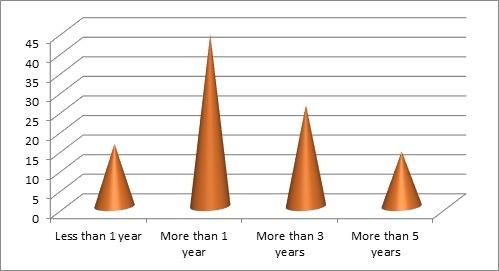
Fig6. Tenure of employment
Findings and analysis-
Above table and figure denotes that most of the respondents of the research are working with TESCO PLC for more than 1 year and the percentage of the people is 44%. This percentage is followed by 26% that signifies the people who are employees at TESCO PLC for more than 3 years. 16% of the participants are the employees of the company is more than 5 years and 14% are the new employees of TESCO PLC who are working for the organisation for less than 1 year.
Q.2 How far is you satisfied with the quality of working environment at Tesco PLC?
|
Options |
Response% |
No. of Respondents |
Total Respondents |
|
Strongly satisfied |
12 |
6 |
50 |
|
Satisfied |
34 |
17 |
50 |
|
Neutral |
28 |
14 |
50 |
|
Dissatisfied |
20 |
10 |
50 |
|
Strongly Dissatisfied |
6 |
3 |
50 |
|
Mean |
Median |
Mode |
SD |
|
2.74 |
3 |
2 |
1.103057 |
|
Table: 2 Satisfaction with quality of working environment | |||

Fig7. Satisfaction with quality of working environment
Findings and analysis-
As described in chapter 2 the primary elements of employee motivation describes the effect of the quality in work on achieving the business objectives. From the above table and figure, it can be seen that 46% (12%+34%) of the respondents are satisfied with the provided quality working conditions of Tesco PLC and 12% of the people are strongly satisfied. However, 26% of the participants are not satisfied with the quality. 6% of them are strongly dissatisfied and 28% people stayed neutral in this matter. As the mode is 2 that denotes that most of the people are satisfied with the quality but as the SD is more than 1 therefore there is a risk factor for the company if they cannot continue with this quality or develop this quality.
Q.3 How far do you agree that TESCO PLC provides the sufficient salary/wages to the employees?
|
Options |
Response% |
No of Respondents |
Total Respondents |
|
Strongly agree |
8 |
4 |
50 |
|
Agree |
26 |
13 |
50 |
|
Neutral |
24 |
12 |
50 |
|
Disagree |
28 |
14 |
50 |
|
Strongly disagree |
14 |
7 |
50 |
|
Mean |
Median |
Mode |
SD |
|
3.14 |
3 |
4 |
1.1954 |
Table: 3 Salary/Wages of the employees
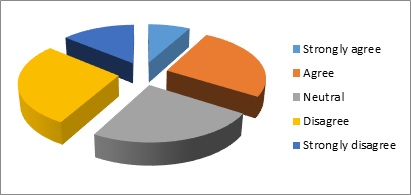
Fig8. Salary/Wages of the employees
Findings and analysis-
In the literature review chapter it has also discussed that how the reward strategy can attract a employee through incentives and rewards. As presented in the table most of the participants are not satisfied with the salary package at TESCO PLC. This category includes (28+14) % = 42% of the participants. 24% of the respondents did not give any opinion in this matter and 34% of the people are satisfied with the salary structure of the company.
The mode is 4 that indicates that most of the participants have not agreed with the matter that TESCO PLC provides sufficient salary package to the employees. SD is more than 1 that is a indication of risk for the company that if the company do not change their salary offering then it can be very harmful for the growth of the company. Therefore, the HR is responsible to assess the market and make considerations accordingly if they are to retain the employees.
Q.4 What are the factors that influenced you to join TESCO PLC?
|
Options |
Response% |
No of Respondents |
Total Respondents |
|
Market Dominance |
24 |
12 |
50 |
|
Recommendations |
16 |
8 |
50 |
|
Brand Value |
36 |
18 |
50 |
|
Growth Opportunity |
24 |
12 |
50 |
|
Mean |
Median |
Mode |
SD |
|
2.6 |
3 |
3 |
1.10657 |
Table: 4 Influencing factors for joining TESCO PLC
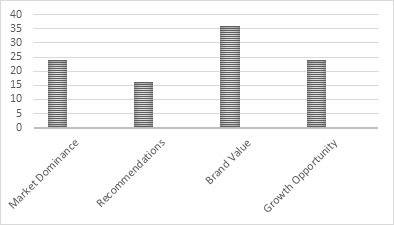
Fig9. Influencing factors for joining TESCO PLC
Findings and analysis-
In chapter 2 the researcher has provide the factors that influence employee motivation in an organisation. Here it can be seen that there are different factors that influenced candidates to join TESCO PLC The above table and figure represents that the factors that influence candidates to join TESCO PLC. 36% of the respondents chose brand value. 24% of the respondents joined TESCO PLC due to their influence and market dominance whereas 16% chose the option of recommendations as they stated of excellent of working environment and facilities for the employees. 24% people selected growth opportunity. The mode denotes that most of the people joined TESCO PLC due to brand value. However, the SD is more than 1 that indicates the risk the company if they cannot maintain their brand value, they won’t be able to retain the employees.
Q.5 Do you agree that TESCO PLC apply effective reward strategies to retain their employees?
|
Options |
Response% |
No of Respondents |
Total Respondents |
|
Strongly agree |
8 |
4 |
50 |
|
Agree |
26 |
13 |
50 |
|
Neutral |
30 |
15 |
50 |
|
Disagree |
24 |
12 |
50 |
|
Strongly disagree |
12 |
6 |
50 |
|
Mean |
Median |
Mode |
SD |
|
3.06 |
3 |
3 |
1.15016 |
Table: 5 Effective reward strategies for retaining employees
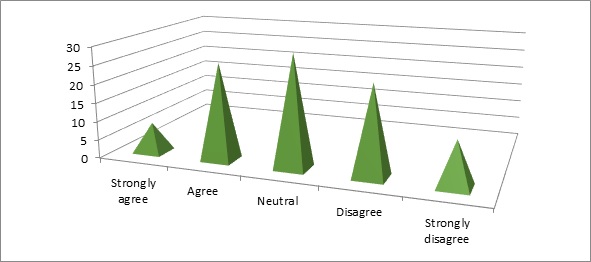
Fig10. Effective reward strategies for retaining employees
Findings and analysis-
The table and figure denotes that 34% respondents agreed the fact that the TESCO PLC applies effective reward strategies to retain their employees. 8% of them strongly agreed the matter. However, 36% participants did not agree the matter and 30% remained neutral.
As the mode is 3, it denotes that majority of the respondents remained neutral in this specific question that creates a confusion over the matter. Beside this SD is more than 1 therefore the company needs to focus on creating and implementing something new for the employees to retain them in the business.
Q.6 How far do you agree that rewards strategy at TESCO PLC has the ability to motivate the employees?
|
Options |
Response% |
No of Respondents |
Total Respondents |
|
Strongly agree |
8 |
4 |
50 |
|
Agree |
22 |
11 |
50 |
|
Neutral |
34 |
17 |
50 |
|
Disagree |
24 |
12 |
50 |
|
Strongly disagree |
12 |
6 |
50 |
|
Mean |
Median |
Mode |
SD |
|
3.1 |
3 |
3 |
1.12938 |
Table: 6 Ability of reward strategy to motivate employees
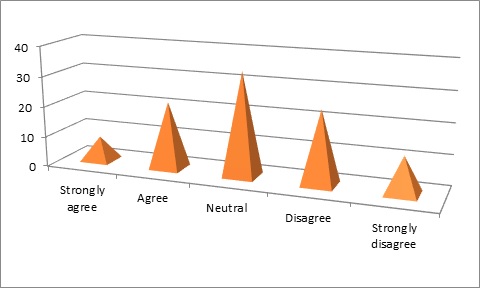
Fig11. Ability of reward strategy to motivate employees
Findings and analysis-
As discuss in the chapter 2 effective reward strategies that have the ability to motivate more employees that has been mentioned in reward management strategy. The above presented table and figure indicates that 30% (8%+22%) of the respondents agreed that reward strategy do encourage and motivate the employees to perform more responsibly at Tesco PLCS, whereas 8% of them strongly believes the matter. However, there are other respondents also who did not agree this and they do not think that the implemented strategies are very much effective and this category’s people signify 36%. The people who did not give their any positive or negative opinion on this question signify 34%.
The mode which is 3 denotes that most of the people remained neutral over the matter therefore again it creates confusion. SD is greater than 1 that indicates a risk factor for the company that if the company do not enhance their effectiveness of the implemented strategies then it can be harmful for their business.
Q.7 Do you plan to resign from the company in coming years?
|
Options |
Response% |
No of Respondents |
Total Respondents |
|
Yes, to high extent |
10 |
5 |
50 |
|
Yes, to some extent |
46 |
23 |
50 |
|
Not at all |
44 |
22 |
50 |
Table: 7 Employee Resignation
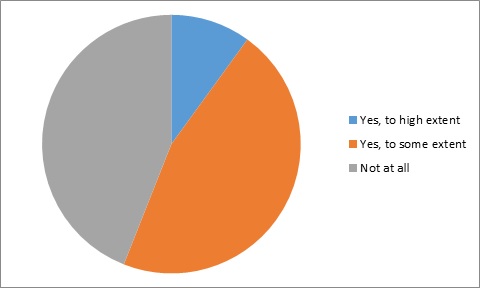
Fig12. Employee Resignation
Findings and analysis-
From the above table it is seen that 46% of the participants are planning to resign from TESCO PLC in the next 10 years whereas 10% of the employee are planning to resign from the organisation soon. However, 44% of the respondents do not have any opinion on this matter.
Q.8 Which other companies do you think has a better job opportunity and security apart from TESCO PLC?
|
Options |
Response% |
No of Respondents |
Total Respondents |
|
ASDA |
12 |
6 |
50 |
|
ALDI |
16 |
8 |
50 |
|
COLES |
18 |
9 |
50 |
|
LIDL |
10 |
5 |
50 |
|
WESFARMERS |
44 |
22 |
50 |
Table: 8 Competitors of TESCO PLC in terms of Job Opportunities
\
Fig13. Competitors of TESCO PLC in terms of Job Opportunities
Findings and analysis-
It has been noted that majority of the employees are opting to work for Wesfarmers since they are the oldest organisation and have a good consumer base. Apart from that, growth opportunities are considerably high in this organisation. Since many organisations are developing new strategies and processes to retain their fellow employees in the business, TESCO has failed to take any initiatives. Next comes Coles which is considered to be another benchmark in the industry. Coles and Wesfarmers are both Australian based companies that have entered UK market and are attracting both the consumers and employees.
Q.9 What are the prime factors that make you stay at TESCO PLC?
|
Options |
Response% |
No of Respondents |
Total Respondents |
|
Positive working environment |
28.57 |
8 |
28 |
|
Growth Opportunities |
53.57 |
15 |
28 |
|
Extra earning opportunities |
17.87 |
5 |
28 |
|
Mean |
Median |
Mode |
SD |
|
3 |
2 |
2 |
0.492365964 |
Table: 9 Factors that retain employees in TESCO PLC
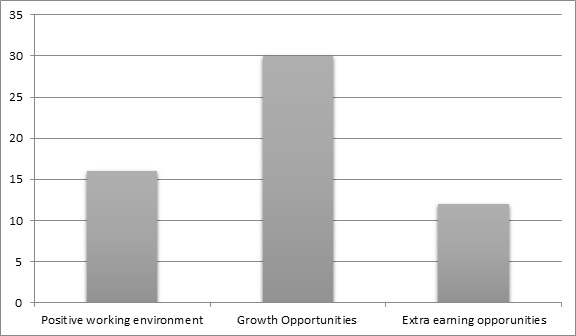
Fig14. Factors that retain employees at TESCO PLC
Findings and analysis-
The above table and figure represents that most of the people stay at TESCO PLC due to growth opportunities. 28.57% stay with the organisation due to positive working environment. 17.87% stated that they are able to earn extra money by doing overtime. These are some of the basic factors that have helped the organisation to retain the employees at TESCO PLC
Here the mode is 2 that denote growth opportunity is the key factor that influence people to to stay at TESCO PLC. SD is less than 1 that denotes there is low risk for the company if they focus on their other segments other than growth opportunities.
Q.10 Which are the areas those should be focused by the HRM of of TESCO PLC to retain its employee?
|
Options |
Response% |
No of Respondents |
Total Respondents |
|
Leaves |
18 |
9 |
50 |
|
Salary Benefits |
44 |
22 |
50 |
|
Growth opportunities |
20 |
10 |
50 |
|
Job security |
18 |
9 |
50 |
|
Mean |
Median |
Mode |
SD |
|
2.38 |
2 |
2 |
0.98747 |
Table: 10 Areas that should be focused by HRM of TESCO PLC

Fig15. Areas that should be focused by HRM of TESCO PLC
Findings and analysis-
In the above table, it can be seen that most of the employee suggested that the TESCO PLC should focus on their Salary Structure and to make employees stay. 44% people suggested for salary benefits and 20% of the participants voted for growth opportunities. 18% of the respondents suggested the company to work on their leaves policy. The mode is 2 that denotes that the company mostly concentrate on their salary structure and benefits to retain the employees. Though the SD is less than 1 that denotes lower risk for the company still the company should think on other factors and not let increase the risk due to this fact.
4.2 Qualitative Analysis
Q.1 what are the factors that are required in creating reward management strategies to retain the employees?
The first manger opines that creating effective reward strategies requires an expert view, knowledge and skill about the all features of a business to create the strategies accordingly. In order to create an effective business strategy it is very important to gather a clear and deeper knowledge about the internal and external factors of the business that can be done by conducting a market research. The result of the research will help the company to analyse the areas where the company needs to be improved as per the demand of the market.
The second and third manager opines almost same that market survey is very important to identify the employment factors before creating a reward strategy. Taking feedback of the employees is considered as the most important aspect of formulating a strategy. These strategies can enhance the reputation of the company and raise the growth of the business.
So it can be said that all the mangers of TESCO PLC agreed the factor that the company needs to conduct market survey before making their strategies those are to be implemented. This will help them to formulate effective strategies that can help them to attract new employees and retain the old employees in an organisation.
Q.2 what are the importance of total reward management strategies on employee retention?
According to the first and second manager in order to survive in the competitive business environment, it is very important to formulate effective strategies by gaining an immense knowledge about the different aspects of the business. A clear analysis of the competitive business environment helps to make competitive strategies. However, the strategies must be innovative also; the competitors cannot easily copy that. These reward management strategies have a great impact on employee motivation and flourish the business by gaining more productivity and performance in the market.
According to the third manager, innovation is very important in recent business world in order to develop appropriate reward strategies. As the market competition is too high in the recent days, therefore, the strategies have to be not only competitive but innovative also and these have the ability to sustain the market position by gaining competitive advantages from the market. Employees have become so much choosy as they have many options to choose their organisation. Therefore, it is getting tougher for the company to attract the employees and gain their loyalty. For this purpose, the company has to be inclined on making and increasing the aptitudes of the implemented strategies that can acquire more candidates. So it is clear that there is a great impact of total reward management programme on employee retention and attraction.
Q.3 What are the strategies implemented by TESCO PLC to acquire more employees?
According to the manager of TESCO PLC, the company implements different strategies to obtain more employees yearly. The first and third manager accessed their view that the aim of the company is not only to retain more employees but also to provide them with growth opportunities. Therefore, TESCO PLC concentrates on those strategies that can earn their employees’ trust and satisfaction. The lifestyle of the people being modernized and their expectations are getting high in terms of salary and growth opportunities. Therefore, while designing a reward strategy it is very crucial to use the process of innovation in order to make the elements quality superior and unbeatable so that the employees get stuck to the company and cannot go to any other company.
As per the perspective of the second manager, TESCO PLC believes in implementing competitive market for other organisations in terms of employee retention. In order to deal with the increasing competitiveness of the business environment it is vital for the company to make their employees satisfied by implementing different rewards and recognition programme tyo retain them in the organisation. Therefore, the company is focused on their salary benefits by using programmes in the process of employee motivation. Beside this, the company is also focused on increasing the salary of the employees and promotion to employees who have contributed in the business for a long time. After taking the opinions of the managers of the TESCO PLC, it can be said various strategies are there. The company implement to carry out their business activities adequately by enhancing employee satisfaction and loyalty.
Q.4 what are the problems faced by the company while making and implementing the strategies?
All the managers highlighted some issues of making and implementing the strategies on their business. The expectations of the employees are getting high with time and if they do not find appropriate leverages for their employees, it is highly possible that the employees will be resign from their post and apply on other organisation that has more prospects for the employees. Therefore, a company has to deal with several issues on formulating and implementing strategies that can satisfy their employees.
As per the viewpoint of the first manager the first problem at TESCO PLC has to face while making the strategy is the re reliability of the data that they have gathered through the internal survey. Lack of the authentication of the collected data acted as a barrier of revising the reward management strategy to promote the contribution of an employee.
The second and third manager opines that making a good strategy can help the organisation to save employees who have been with the organisation for a long time and appreciate their contribution effectively and harness their talent to circulate to other employees. This acts as a motivational factor for the employees and also increases the productivity and performance from within. It is also seen that while implementing these reward strategies by TESCO PLC, they have to face various problems limitations those are stated by the mangers of the company.
4.3 Summary
In this chapter the researcher, gain the opinions of the managers and employees of TESCO PLC in order to gain a deeper knowledge about the concerned topic. The collected data of the research have been presented through various figures that will help the reader to understand the different factors of the research easily and clearly.
Chapter 5 - Conclusion and recommendation
5.0 Conclusion
Based on the topic of the research that is a critical evaluation of reward management strategy implemented in MNC’s organisation for achieving the benchmarking process, the researcher has collected data that has been analysed by the researcher and in this chapter, the researcher links the research objectives with the findings of the research. This will help the researcher to identify the loopholes of TESCO PLC and provide recommendation accordingly. In this chapter, the researcher will also mention the issues or limitations that have been faced by the researcher while carrying out the research and the further scope of the research.
5.1 Linking with the objectives
Linking the research findings with the research objectives helps the researcher to analyse the success or failure of the research.
Linking objective 1: To understand the reward management strategy
In the literature review chapter, the researcher has given a detail description about the concepts of competitive yet innovative strategies. It explains about the innovative strategies and their effectiveness and how the strategies can be formulated. The researcher has discussed matter deeply in chapter 2. In the qualitative part of chapter 4 question describes the important factors regarding salary benefits, growth opportunities and other employee benefits ion an organisation.
Linking objective 2: To analyse the importance of the bench marking process of the MNCs organisation
The literature review chapter provides a brief description of this objective. The quantitative and qualitative questions of chapter 4 also give the answers of the impact of implementing total rewards management strategy and programme for employee retention. In chapter 2 the theory related to the topic has been discussed. TESCO PLC applies different innovative strategies to retain their employees. The link of the findings on this with the objective clearly states that there is a positive influence of motivational and rewards strategies for retaining employees and maintaining the market position.
Linking objective 3: To evaluate the impact of the reward management strategy to achieve the benchmarking process for Tesco Plc
In chapter 4, in the quantitative part almost all the questions are framed to find out the loopholes of TESCO PLC. In the qualitative part question, a section is made to understand the problems those are faced by the company. This will help TESCO PLC to make their strategies as per the employees’ need.
Linking objective 4: To find the related issues of implementing the reward management strategy and to suggest some recommendations accordingly
In the quantitative part of chapter 4, the researcher takes the opinion of the employees over the matter that in which areas TESCO PLC needs to focus. Most of the employees suggested the company to think on improving the salary structure and additional benefits if they want to retain the employees. According to the respondents, the salary structure and benefits of TESCO PLC is not appropriate.
5.2 Recommendation
The researcher segregates the information pertaining to the loopholes of TESCO PLC and suggests few recommendations.
Revising the salary structure of the old employees
Most of the respondents suggested the company for changing their salary structure. It proves that the employees are not satisfied with the salary breakdown offered to them by the company therefore; the company needs to redesign the same. This will help them to retain the old employees as well as attract new employees in the future. It is essential for the organisation to consider various factors that can help in improving the working conditions by motivating them financially.
Growth Opportunities for the old employees
In order to increase the effectiveness employees and productivity of the organisation, it is essential for the organisation to consider promoting the employees who have been serving the organisation for a long time. This will help them to motivate the other personnel in the organisation to improve their performance to increase the overall productivity.
5.3 Limitations of the research
The limitation of this research is the limited budget and restricted timeframe for which the researcher has to select a small sample size and due to this fact, the researcher cannot gather deeper knowledge about the concerned topic. The SPSS software can also not be used by the researcher for the limited budget.
5.4 Further scope of the study
Although the research has been under some limitations and ethical issues, still there is a scope for future research. The data that were collected in this research can be used as secondary source for future and the future researcher can be able to carry out a comparative research of other company with TESCO PLC.
Reference List
Books
Armstrong, M. (2008) Strategic Human Resource management. A Guide to Action. 4th ed. London: Kogan Page Ltd.
Adair, J. (2010) Strategic Leadership: How to Think and Plan Strategically and Provide Direction, 3rd ed. London: Kogan Page
Edd, J. K. (2011) Strategic Leadership: Leading Change in a New Age, 3rd ed. London: Harvester Wheatsheaf.
Smither, J. (2006) Performance appraisal: state of the art in practice. 5th ed. New York: Leadership Press.
Bremen, J.M., Sejen, L. And Watson, T. (2012) Advancing Total Rewards and The Employee Value Proposition. The Magazine at World at Work
De Wit, B and Meyer, R (2010) Strategy; Process, Content, Context. An International Perspective. Fourth Edition. South- Western, Cengage Learning
Bellamy, C. (2012). Principles of methodology. Los Angeles: SAGE.
Bergh, D. and Ketchen, D. (2013). Research methodology in strategy and management. Bingley, UK.: Emerald Jai.
Bryman, A. and Bell, E. (2011) Business Research Methodology. 3rd ed. New York: Oxford University Press,
Saunders, M. N., Lewis, P. and Thornhill, A. (2009) Research methods for business students, Page 52, 5th ed. Harlow: Prentice Hall
Journals
Hope Hailey, V., Farndale, E., and Truss, C. (2005). “The HR department’s role in organizational performance”. Human Resource Management Journal, 15(3), 49-66
Lawler, J. (2008). “Strategic human resource management”. Handbook of Organization Development, p. 353.
Lawler, E.E. (2003). “Treat people right. San Francisco: Jossey-Bass Inc. Mason, L.J. (2001). Retaining Key Personnel. Plus” Top15(3), 49-66
Camardella, M.J. (2007) “Effective Management of the Performance Appraisal Process,” Employment Relations Today, 30(1), 103-107.
Chan, Y. C. L. and Lynn, B. E. (2008) “Performance Evaluation and the Analytic Hierarchy Process,” Journal of Management Accounting Research, 57-87.
Moore, F (2007). “Work-life balance: contrasting managers and workers in an MNC”. Employee Realtions, 29 (4), 385-399
Freshwater, D. (2007) “Reading mixed methods research: contexts for criticism”, Journal of Mixed Methods Research, 1(2), pp. 134-146.
Harrison, R. L. and Reilly, T. M. (2011) "Mixed methods designs in marketing research", Qualitative Market Research: an International Journal, 14(1), pp. 7 – 26
Huxham, C. and Vangen, S. (2008) Researching organizational practice through action research: Case studies and design choices. Organizational Research Methods, 6, pp- 383-404.
Johnson, R. B., Onwuegbuzie, A. J. and Turner, L. A. (2007) “Toward a definition of mixed methods research”, Journal of Mixed Methods Research, 1(2), pp. 112-133
Knox, K. (2008) A researchers’ dilemma: Philosophical and methodological pluralism, Electronic journal of business research methods, 2(2), pp. 119- 128.
Magilvy, J. K. and Thomas, E. (2009) ‘A first qualitative project: Qualitative description design for novice researcher’, Journal of the Society for Paediatric Nurses, vol. 14, no. 1, pp. 298-300.
Morgan, D. L. (2007) “Paradigms lost and pragmatism regained: methodological implications of combining qualitative and quantitative methods”, Journal of Mixed Methods Research, 1(1), pp. 48-76.
Onwuegbuzie, A. J. and Leech, N. J. (2009) On becoming a pragmatic researcher: The importance of combining quantitative and qualitative research methodologies. International Journal of Social Research Methodology, 8, 375-387.


